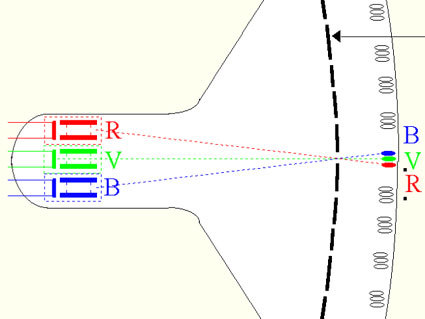Comparison: Twelve 19" CRT Monitors
The Technologies
CRT monitors have at least one feature in common - they all have a cathode ray tube. The tube is a vacuum casing containing several elements. A cathode ray emits electrons when it is heated. The electron gun bunches the electrons and fires them towards the anode, which draws the beam to the front of the tube. As it leaves the gun, two coils containing an electrical current deflect the beam. One is for vertical deflection, the other for horizontal. The more positive coil attracts the negative electron beam, more or less. So, the basic principle of the tube implies fewer mobile parts and ensures good reliability. For monitors displaying color images, there are three electron guns, each handling a basic color - red, green and blue. This is known as additive color technology. Shades on the screen are made up of the three colors in varying degrees of intensity, and are brought out by drops of phosphor at the surface of the tube. These drops are very close together and make the eye perceive the result of the three impacts as a single pixel.
Theoretically, this results in identical colors, but it is mainly in the way the beam strikes the mask in front of the screen that the technologies differ from manufacturer to manufacturer.
Get Tom's Hardware's best news and in-depth reviews, straight to your inbox.
-
lolsir Hi!! I am from 2010 and i want to tell you guys that you guys had some really nice boring review back in the days without any graphs...Reply -
I just took a Hitachi CM721F into daily use alongside Hitachi CM771, the shadow mask CRT does offer good color rendition without visible support wires of Trinitron-type solution.Reply
--
-FurryWolf -
CHISEL_954 iiyama Vision Master Pro 514 22" CRT .24 Bought back in 2004 (wow time flys) and still looking at it as i type. What a excellent monitor (still). I think around $500 bucks in 04. I had a different iiyama model 5 years before that. So the crt's where made of great quality that lasted--but i don't think the lcd that they make are near the quality of the past. :(Reply
